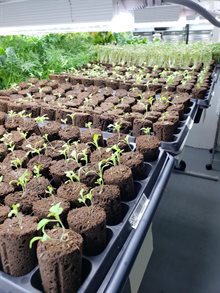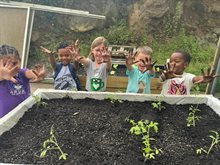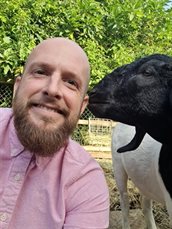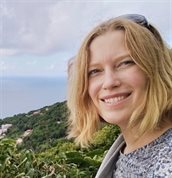Island Voices: Justin Simmons and Sarah van der Horn from Saba
In the Caribbean part of the Kingdom, climate change is already being felt by people on the islands. It is getting warmer, periods of drought are increasing and when rain falls, much more falls in a shorter period of time. Moreover, hurricanes are becoming more powerful. How should the islands adapt to this? What is happening to prepare the islands and islanders for the future? In the series of interviews ‘Island Voices’, residents from different islands and with different areas of expertise talk about how they view climate change and adaptation.
This time, meet Justin Simmons-de Jong and Sarah van der Horn-Plante from Saba. Justin Simmons is a project manager in nature restoration at the Public Entity Saba. He is also a goat farmer. Sarah van der Horn is the program manager of the Nature and Environment Policy Plan (NEPP) at the Public Entity Saba.
Want to know more about climate adaptation in the Caribbean islands? On the knowledge portal you will now also find a section on the Caribbean part of our kingdom.
Why are you concerned with climate adaptation on Saba?
Justin: “One of the main reasons we are concerned with climate change and adaptation on Saba is that our island is very vulnerable: it is small and it is in a remote location. We are very dependent on products that come from the outside world, including most of our food. That food is produced somewhere else and then shipped to Saba. Imported products are shipped from Miami to St. Maarten, and from there it is shipped to Saba. Saba is at the end of this line. That means the effects of climate change in the countries we depend on also affect us. At the same time, we are being hit hardest by the effects of climate change, even though we barely contribute to CO2 emissions. Periods of drought last longer, interspersed with intense downpours. The strength of hurricanes is also increasing. And these have a huge impact on Saba.”
How can you become more resilient against the effects?
Justin: “To be more resilient to the effects of climate change, it is important to become more self-sufficient, including in the following areas: water availability and management, energy and food security. For freshwater, we are very dependent on rainwater. There is a cistern under all houses on Saba that collects rainwater through the roof. Some residents even use this water as drinking water. Also, Saba has a desalination plant that desalinates sea water through a process called reverse osmosis. In addition, the energy company has laid the overhead cables and pipes of its distribution network underground. In the event of a hurricane, this part of the network is safe. During hurricanes Maria and Irma in 2017, almost all of Saba had electricity about 12 hours later. While parts of nearby islands sometimes had no electricity for days, weeks and even months. The goal is to ensure that when the oil supply lines stop, we can still keep our lights on. So, in this respect, we are already in a good trajectory.”
Sarah: “We have two solar parks on Saba that generate almost 40 per cent of the electricity demand. When the sun shines – which it does almost every day on Saba – these provide all the energy between 8am and 5pm. The diesel power plant shuts off. Another solar park is also in the works, which will raise the share of renewable energy on the island to 89 per cent. You may now be asking yourself, ‘Solar energy, isn’t that a mitigation issue?’ But for Saba, the energy supply is part of the measures we need to take to adapt. It is a key element in becoming more self-sufficient. And as a small island with so much renewable energy, we can also serve as a showcase, I think. We can share our knowledge and experiences with the rest of the world.”
Justin: “In addition, we want to improve food security. To this end, a hydroponics farm has been set up, where you grow crops in pipes and water with nutrients that’s circulated in a system. On Saba, the crops are grown outdoors where there is an abundance of light. As a safety measure, we have built a sort of bunker that can be used during hurricanes to continue growing crops indoors. All our hydroponic systems are equipped with wheels so they can be outside when the sun shines. But in case of a hurricane, we want to be able to put them inside safely. So with the right lighting, we can continue growing during a hurricane without destroying the crop. And after the hurricane, we move everything back outside. This way, we can still have fresh food after a hurricane.

After Irma in 2017, our port sustained damages and logistics in Sint Maarten had come to a halt due to widespread damage on the island. But Sint Maarten's port is indispensable for Saba as a transport hub. It took three weeks for us to have fresh food on Saba again. As I said, Saba is at a logistical endpoint: if Sint Maarten's port does not function, we are immediately in trouble, even if our own port is still operational.”
What else does Saba need to become more resilient to the impacts of climate change?
Justin: “What we need is an integrated climate plan that addresses both the primary and secondary impacts of climate change. That forms an important part of the task Sarah and I have: to draw up a climate plan for Saba. We know what the primary impacts are from hurricanes, rising temperatures and extended periods of drought. But what are the secondary impacts, on tourism, for instance? Or the economy? What are the health impacts? The mental health impacts too. Because experiencing a hurricane can be a traumatic event. A climate plan needs to address that too. We also need to understand more about how the effects of climate change in other parts of the world could affect Saba. That is, of course, complicated. And furthermore, we need help and support in this. We need knowledge and expertise to draw up such a climate plan. And also important: finance to implement adaptation measures.”
What do you expect from the Netherlands?
Justin: “The support I was just talking about. A good example is the organisation of the IPDC conference at the end of March in Rotterdam through which you create a network of countries, experts and financial institutions to think together out of the box about new ideas and solutions.”
Sarah: “What is also important is that the European Netherlands has a good understanding of the local perspective, the local context and the local challenges. When it comes to sustainability, we sometimes get the advice to be more careful with our water on Saba. But on Saba, we know that very well and we are already extremely careful with our water, because we are largely dependent on rainwater and desalinated water is very expensive. The European Netherlands could learn something from us in this respect. In the climate plan for Saba, technological, scientific data and local knowledge and experience must be aligned.”

What do you want to leave to future generations?
Justin: “Speaking for myself, I think we have brought about climate change through our careless behaviour. And I feel we owe it to the planet and every living creature that is on this planet to work to undoing what we have done, or at least do as much as we can. It is important that we hand future generations a world where they can live healthy and safe lives, without having to worry about whether there is enough water. And without having to fear running out of food. Without them having to fear a huge storm that will endanger their families or threaten to destroy their homes. How can we ensure that vulnerable people can also have a good life? There will always be vulnerable people and they will be hit hardest by the effects of climate change. So we will have to be mindful of these people, now and in the future.”
About Justin Simmons-de Jong
Justin Simmons was born and raised on Saba in the Dutch Caribbean. It’s on his family farm growing up as a child and in the tropical forests on the island where he gained his passion for agriculture and nature. He obtained his bachelor’s degree English Language and Literature in the US and master’s degree at Leiden University in the Netherlands. Following his studies, he returned to Saba to help contribute to its further development. He currently works at the Public Entity Saba as a project manager in nature restoration projects within the Nature and Environment Policy Plan. When he’s not growing trees with his project team for Saba government’s reforestation project, he’s at home, on the farm, tending to his goats together with his husband.
About Sarah van der Horn-Plante
Sarah van der Horn has been passionate about nature and climate since childhood. After earning a bachelor's degree in biology, where she deepened her understanding of climate change pressures, she continued with a master’s degree in the field of sustainable development. She started her career as a government trainee at the Dutch ministry of Infrastructure and Environment and first visited Saba during a six-month secondment as part of this traineeship. Over the past seven years, she has primarily worked in the Caribbean region, especially for the Public Entity Saba. Currently, she works as the program manager for the Nature and Environmental Policy Plan at the Public Entity Saba. This plan aims to conserve and restore nature while promoting the sustainable use of natural resources on and around the island.

Justin Simmons

Sarah van der Horn